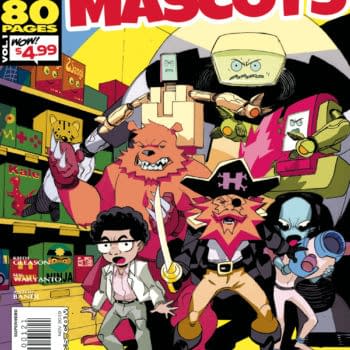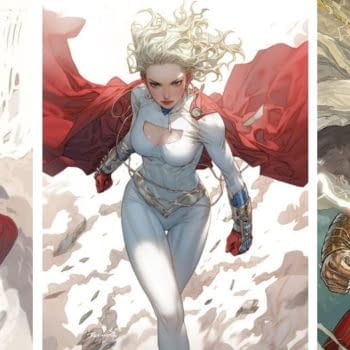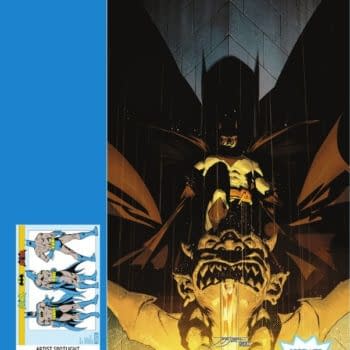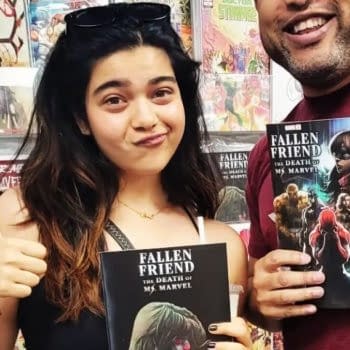Posted in: Comics | Tagged: Comics, dc, entertainment, gendercrunching, marvel
Gendercrunching August 2012
Tim Hanley writing for Bleeding Cool
The percentage of female creators at the Big Two went up for both publishers in August, by a smidge for DC and by a decent amount for Marvel, who stayed in the top spot. We also take a look at female fandom, and get some rough estimates about the female audience for comic books.
DC COMICS
Well, at least DC is back in double digits. In August 2012, DC Comics put out 89 new books with 755 credited creators, 679 men and 76 women. Here are their stats:
DC is up 0.2% from last month, but this is still below average for them. It was a mixed bag for the categories, though. Cover artists, pencillers, inkers, and colorists all went up 1-2%, which is good to see, especially for the perennially low artists. However, there were slight drops for writers and colorists, and both editorial categories fell more than 2%. All together, there were some slight changes across the board for a marginal gain overall, but DC is in a rut lately.
Compared To A Year Ago: DC was at 10.8% in August 2011, so they're down 0.7%.
MARVEL COMICS
Marvel had a very strong month, beating DC for the top spot yet again and by a fair margin. In August 2012, Marvel released 84 new comics featuring 700 credited creators, 612 men and 88 women. Here are their stats:
Jumping up 1.4% overall is a solid gain, and Marvel had some sizeable increases by category too. While cover artists, pencillers, and inkers were down just slightly, writers went up 1.3%, colorists and editors rose in the mid-2% range, and assistant editors jumped an impressive 9.5%. Letterers remained the same at zero. Some more interior artists would be really nice, but apart from that Marvel had a good month.
Compared To A Year Ago: In August 2011, Marvel was at 8.9% overall, so they've risen 3.7% since then. Wow, that's really quite good.
THE COMIC BOOK INDUSTRY'S FEMALE AUDIENCE
Usually we look at stats about comic book creators, but this month we're going to mix it up some and talk about the female audience for comic books, both actual and potential. There's not a ton of data on this subject, but I've found some numbers from several sources that paints an interesting picture overall. Now, a sizeable female audience doesn't necessarily mean that there should be a commensurate number of female creators, though we'll see in some cases that the divide is pretty ridiculous. However, having female creators, especially in the gigs that get your name on the cover, sends the message that comics are for ladies too and encourages this audience to grow. Wall to wall dudes says "NOT FOR YOU!!".
So first, let's talk about the DC Nielsen Survey. This has come up a few times in the past, and the numbers were divided by in store surveys, online surveys, and digital purchase surveys. What I've done here is calculated the raw numbers, added them up, and created a composite percentage. Across the three different surveys, DC had 6,129 participants. 4,846 were men and 1,283 were women, so 20.9% of the survey of DC readers was female. That's a big number. In comparison, only 1.7% of credited writers on DC's comics in August were women. Should 20.9% of DC's writers be women? That'd be fun, but probably not very feasible right away. However, should the percentage of female writers be 1/12 the percentage of female readers? That seems like a massive gap.
Over at Ladies Making Comics, Alexa found that she could calculate the number of people who identified as comic book fans on Facebook. Of these 1,167,780 fans in the USA and UK, she found that 36.7% of comic book fans on Facebook are female. That's an even bigger number. Of course, they aren't all necessarily superhero fans, but superheroes are the dominant comic group in both of these countries. If you combine DC and Marvel's numbers for writers and pencillers, you get 3.7% female writers and 2.7% female pencillers. So female writers are about 1/10 of female comic book readers on Facebook by percentages, and pencillers are even worse at almost 1/14. These are massive gaps as well.
Comic conventions also show that there are a lot of female comic books fans. Sure, some of them go for the movies and TV shows, but so do lots of the guys. It's not like 96% of the guys go for comics and 96% of the girls go for Twilight. That's just ridiculous. At San Diego Comic Con this year, 40% of the attendees were women, while estimates from a couple of weeks ago at New York Comic Con put the number of female attendees between 40% and 50%. This is a very big crowd of ladies, all of whom are a huge potential audience for the Big Two.
Similarly, superhero movies attract impressive numbers of female fans. Take a look at these audience numbers from the opening weekends of the three big superhero movie releases from this past summer:
- Dark Knight Rises: 36% female
- The Avengers: 40% female
- The Amazing Spider-Man: 42% female
Girls are going to superhero movies, and in droves. Hell, even Dredd, an R-rated movie that bombed in North America, had 25% female viewers on its opening weekend. Are all of these women going to run from the theatres to the comic shops to load up on books? Of course not. Are these MASSIVE numbers of women an audience that the industry should be targeting? Of course.
There was a cool letter in the latest issue of Hawkeye (bros, you should be reading this book, bros) from a woman named Lisa who is new to comics and who got into Marvel after seeing their movies. She found the new Hawkeye series accessible and free of the confusing continuity that plagues a lot of superhero comics, and now Marvel has a new female fan. Now, this is only one person, but it demonstrates how the industry can do something with this potential female audience.
At the same time, Hawkeye #3 also included a Susan G. Komen for the Cure breast cancer strip starring Captain America and Iron Man. Tony was distracted at the Avengers' last battle because of a potential breast cancer scare, but it turns out that his tests all came back fine. On the one hand, it's great to remind people that breast cancer can affect men. On the other hand, there's NO mention that breast cancer also affects women, or what they should do. It's all about male breast cancer, despite the fact that in the USA men account for less than 1% of all cases each year. This is a bizarre example of how the comic book industry sees their audience. Why mention ladies when you're talking about breast cancer, even though they make up 99% of the cases? Ladies don't read comics.
Except that they do. Men are the majority, but there's a sizeable female audience too. There's also massive potential audiences through conventions and movies that could be tapped into if the industry wanted to try. But that's the key: They have to want to try.
NOTES:
To learn more about this statistics project and its methodology click here, and to see the previous stats click here. You can visit Tim at Straitened Circumstances and follow him on Twitter @timhanley01.















